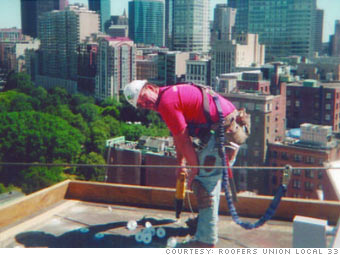
Roofer protection includes a flexible safety harness.
Fatality rate per 100,000 workers: 32
Median wage: $37,880
Any time a job involves heights, it raises the level of risk. And while there are a lot more precautions taken to secure roofers these days, there are still a large number of fatalities.
Just a couple of weeks ago, an unidentified roofer in Mesa, Ariz. was working on a senior living center and tumbled 35 feet to his death.
Luckily, falls like the one in Arizona are becoming an anomaly. According to the Bureau of Labor Statistics data, roofer fatalities have decreased by about 17% over the past two years to 57 in 2010.
Part of that decline is due to that fact that roofers are now receiving safety education that they didn't get 10 years ago, said Ed Rolfe, a roofer in Massachusetts with 40 years experience who is now a training director for Roofer's Local 33.
Today, every roofer in Massachusetts is required to take an intensive 10-hour safety course, which includes learning how to use safety equipment, he said.
OSHA also teaches roofers how to deal with other common on-the-job hazards like fire and electric shock.
In addition to training, equipment and other measures have been put in place to insure worker safety.
"There's a safety harness that keeps you on the roof," said Rolfe. "It doesn't allow you to get to the edge. If you do go over the edge, it catches you and it has shock absorbers to keep you from getting injured."
NEXT: Sanitation worker